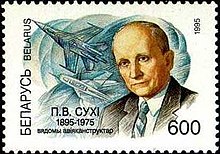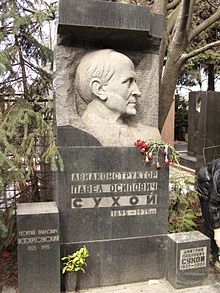Pavel Ossipovich Sukhoi
Pavel Sukhoi ( Russian Павел Осипович Сухой ., Scientific transliteration Pavel Osipovic Suchoj * 10 . Jul / 22. July 1895 greg. In Glubokoe in Vitebsk , now Belarus ; † 15. September 1975 in Moscow ) was a white Russian / Soviet aircraft designer and acted as chief designer of the OKB ( experimental design office ) Sukhoi named after him .
Live and act
Suchoi was born the son of a teacher, attended high school in Gomel and then studied from 1914 at the mathematics and physics faculty of Moscow University , but had to interrupt his studies in 1916 because he was drafted into the military. There he attended an ensign school and was transferred to the front in February 1917. After his release, Sukhoi started studying again in 1920. In 1924 he also worked as a technical draftsman at the Central Aero-Hydrodynamic Institute , where he worked on the project of a single-seat fighter aircraft as a diploma thesis . In 1925, after successfully completing his studies, he was accepted as an engineer at the ZAGI and was assigned a development group in the AGOS test aircraft construction department by Andrei Tupolew , who was the head of the ZAGI and recognized Sukhoi's talent. There Sukhoi worked on the cantilever all-metal bomber aircraft ANT-4 and in 1927 designed the fighter aircraft ANT-5 .
In 1932 Sukhoi became head of department, and a short time later Tupolev's deputy chief designer. Under his direction, the aircraft RD ( ANT-25 ) and DB-2 were developed in the 1930s . From 1939 Sukhoi was the head of his independent design office. The series-produced Su-2 bomber was built there in the same year . But none of his developments from the time of the Second World War resulted in larger series. Although his aircraft often showed better flight performance than the mass-produced models of other Soviet designers, they preferred to develop them further instead of giving Sukhoi a chance. They did not want to take any risks and therefore opted for the tried and tested constructions; Suchoi's constructions were also classified as too complex. In addition, the company wanted to avoid production downtimes when switching to a completely different aircraft, and the training effort for a completely new aircraft was assessed as too high.
After the war, Sukhoi began, like other Soviet design offices, to develop jet aircraft, but was not very successful. After the development of the modern Su-17 was discontinued, the Council of Ministers of the USSR decided on November 14, 1949 to close its OKB. Sukhoi switched back to Tupolev and took over as his deputy the production preparation for the Tu-14 bomber . Only after Stalin's death was his design office re-established in 1953.
The developments of fighter and bomb fighter planes after this period are associated with Sukhoi's name. A large number of groundbreaking aircraft designs were developed under his leadership, and often, for example with the Suchoi T-4 , new technical territory was broken.
Sukhoi gradually withdrew into private life after 1970, after he was only able to manage his OKB to a very limited extent from around 1960 due to health problems and with the help of his right hand Yevgeny Ivanov. He died in 1975 of the sequelae of tuberculosis from the time of the Second World War in the Barwicha sanatorium near Moscow. His tomb is located in Novodevichy Cemetery in Department 7, Row 11.
Sukhoi was a holder of the Order of the October Revolution , two-time hero of socialist labor (1957 and 1965), doctor of technical sciences (1940), three-time holder of the Order of Lenin and twice (1943 and 1975) received the State Prize of the USSR . He also held the function of a member of the Supreme Soviet .
The aircraft developed and built in large numbers under the direction of Pavel Sukhoi include:
- Sukhoi Su-7 , Mach-2 fighter and bomb fighter aircraft , 1955
- Sukhoi Su-9 , Mach-2 interceptor, 1957
- Suchoi Su-15 , Mach-2 interceptor, 1962, in use until 1993
- Sukhoi Su-17 / Su-20 / 22 , swing-wing fighter- bomber
- Sukhoi Su-24 , two-seat swing-wing bomber, 1967
literature
- Wilfried Copenhagen : Lexicon Soviet Aviation . Elbe-Dnjepr, Klitzschen 2007, ISBN 978-3-933395-90-0 .
- Wilfried Bergholz: Russia's great aircraft manufacturer. Jakowlew, Mikojan / Gurewitsch, Suchoj. The complete type book . Aviatic, Oberhaching 2002, ISBN 3-925505-73-3 .
- Nikolai K. Subbotin, Peter Stache: The planes of Pawel Sukhoi . In: Aviation calendar of the GDR . 1986, ZDB -ID 192211-7 , p. 50-65 .
- Лидия Кузьмина: Генеральный конструктор Павел Сухой. Страницы жизни. Молодая гвардия, Москва 1983.
Web links
Individual evidence
- ^ Rainer Göpfert: 80 years OKB Suchoi. Russia's fighter aircraft uz smithy. In: Fliegerrevue No. 12/2019, p. 25
| personal data | |
|---|---|
| SURNAME | Sukhoi, Pavel Ossipovich |
| ALTERNATIVE NAMES | Сухой, Павел Осипович (Russian); Suchoj, Pavel Osipovič (scientific transliteration) |
| BRIEF DESCRIPTION | Russian aircraft designer, chief designer of the Sukhoi design office named after him |
| DATE OF BIRTH | July 22, 1895 |
| PLACE OF BIRTH | Glubokoje near Vitebsk , today Belarus |
| DATE OF DEATH | 15th September 1975 |
| Place of death | Moscow |

